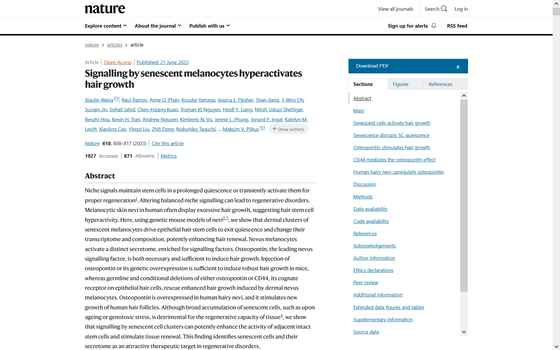It turns out that the aged pigment cells in the mole ``grow long and thick hair firmly'', a new light for baldness treatment

Researchers at the University of California, Irvine, have discovered that aged pigment cells in moles have the ability to promote hair growth. This discovery may open up new avenues of treatment for hair loss symptoms.
Signaling by senescent melanocytes hyperactivates hair growth | Nature
https://doi.org/10.1038/s41586-023-06172-8

Reversing Baldness: Surprising New Molecular Mechanism Discovered for Stimulating Hair Growth
'Mole' that occurs on the human body often grows thick and long hair that is different from the surrounding hair. This phenomenon is derived from the fact that the cell division of the skin of the mole is very active, but the research team led by Mr. Xiaojie Wang conducted research to dig deeper into this phenomenon.
Wang et al. used mice with moles (pigment spots) in which stem cells deeply involved in the function of hair were overactivated, and analyzed in detail the aging of pigment cells and the stem cells near pigment spots. As a result, it turns out that aged pigment cells produce a large amount of a signal transducing substance called `` osteopontin '', and hair stem cells have a receptor molecular body called `` CD44 '' corresponding to osteopontin.

As a result of further investigation, when osteopontin and CD44 interacted at the molecular level, hair stem cells were activated and hair began to grow firmly. To confirm the role of osteopontin and CD44 in this process, Wang and colleagues conducted a survey using mice lacking one of the two genes. They found that mice lacking either osteopontin or CD44 had significantly slower hair growth.
From this, Wang et al. conclude that aged pigment cells are deeply involved in the production of substances that promote hair growth. “Osteopontin activates stem cells in small hair follicles that are normally dormant, allowing them to grow strong, long, thick hair. It accumulates in tissues and is thought to accelerate aging, but our research clearly shows that cellular aging has a positive side as well.'
``If we know more, we may be able to develop new hair loss treatments that take advantage of the characteristics of senescent cells,'' wrote Wang et al.
Related Posts:
in Science, Posted by log1p_kr







